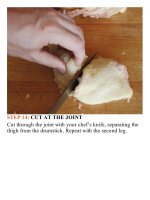The food lab better home cooking through science ( PDFDrive ) 351
Bạn đang xem bản rút gọn của tài liệu. Xem và tải ngay bản đầy đủ của tài liệu tại đây (133.83 KB, 2 trang )
canwedothisourselvesathome?
Igotmyhandson80poundsofPrime-gradebone-in,fatcap-intact beef ribs to get my answers. Over the course of
twomonthsorso,Iagedtheminclosetoadozendifferent
ways in order to determine what works, what doesn’t, and
whatmatters.Here’swhatIfound.
ThePurposeofAging
Q:Howdoesagingwork?
Good question! First, a brief rundown on why you might
wanttoagemeat.Conventionalwisdomcitesthreespecific
goals when dry-aging meat, all of which contribute toward
improvingitsflavorortexture.
Moisture loss is said to be a major factor. A dry-aged
piece of beef can drop up to 30 percent of its initial mass
through water loss, which concentrates its flavor. At least
that’s the theory. But is it true? [Cue dramatic
foreshadowingmusic.]
Tenderizationoccurswhenenzymesnaturallypresentin
the meat act to break down some of the tougher muscle
fibers and connective tissues.A well-aged steak should be
noticeablymoretenderthanafreshsteak.Butisit?
Flavor change is caused by numerous processes,
including enzymatic and bacterial action, along with the
oxidation of fat and other fat-like molecules. Properly dryaged meat will develop deeply beefy, nutty, and almost
cheese-likearomas.
Q:Butisagedmeatreallybetterthanfreshmeat?
Itdepends.Ihadapaneloftasterstestmeatsagedtovarious
degrees and rank them in overall preference, tenderness,
andfunkiness.Almosteverybodywhotastedmeatthathad
beenagedforacoupleofweeks—thetimebywhichsome
degree of tenderization has occurred but seriously funky
flavor has yet to develop—preferred it to completely fresh
meat.
But folks were more mixed about meat aged longer than
that. Many preferred the more complex, cheese-like flavors
that develop with meat aged for between 30 and 45 days.
Some even liked the really funky flavors that developed in
45- to 60-day meat. Where you lie on that spectrum is a
matterofpersonaltaste.Ipersonallyprefermeatagedfor60
days,butbeyondthat,itgetsalittletoostrongforme.
Q:OK,I’msold.ButwhywouldIwanttodoitathome
whenIcanorderitonlineorfrommybutcher?
Two reasons: First, bragging rights. How awesome is that
dinner party where you can say to your friends, “Like this
beef?Iageditfor8weeksmyself,”gonnabe?
Second,itsavesyoumoney.Lotsofmoney.Agingmeat
takestimeandspace,andtimeandspacecostmoney.That
cost gets passed on to the consumer.Well-aged meat costs
anywhere from 50 to 100 percent more than an equivalent
pieceoffreshmeat.Athome,solongasyouarewillingto
give up a corner of your fridge or you have a spare minifridge,theextracostsareminimal.
You may have heard that in addition to the time and
spacerequired,muchofthecostofagedmeatcomesdown
to the amount of meat that is wasted—that is, the meat that
dries out and needs to be trimmed off.This is not as big a









